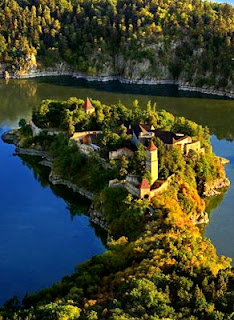Royal House in Přemyslovec
The history of Zvíkov Castle, Czech Republic begins at the grand royal house in Přemyslovec. Zvíkov Castle is a
prominent example of medieval Czech secular architecture. The initial
construction of Zvíkov during the rule of Wenceslas I (1230 - 1253). Written
records refer to Conrad, founder of the Lords of Janovice, as a burglary in
1234. Zvíkov was a favorite of King Wenceslas I, who was often staying here.
Pysemysl Otakar II
eventually ruled the Czech lands (1253-1278), and continued to build the
castle. He was appointed Herza as friend of Zvíkov in the year 1250. Under
Herza, the main construction of the interior began, including the royal palace
and the surrounding fortifications.
 In 1306, Přemysl's house was extinguished with the
assassination of Wenceslas III at Olomouc, so that the castle was ceded to Henri de Rožmberk. The castle obtained
its greatest fame under Charles IV, who completely renovated it. Until the
completion of Karlštejn Castle,
Zvíkov served as a sanctuary for the crown jewels. The significance of Zvíkov
as a prominent palace diminished when this difference was lost. Shortly after,
the castle began to change hands frequently, as it was given as a pledge of
service or monetary loans. Zvíkov was most often exchanged between two
important and wealthy families - the lords
of Rozmberk and the lords of
Švamberk.
In 1306, Přemysl's house was extinguished with the
assassination of Wenceslas III at Olomouc, so that the castle was ceded to Henri de Rožmberk. The castle obtained
its greatest fame under Charles IV, who completely renovated it. Until the
completion of Karlštejn Castle,
Zvíkov served as a sanctuary for the crown jewels. The significance of Zvíkov
as a prominent palace diminished when this difference was lost. Shortly after,
the castle began to change hands frequently, as it was given as a pledge of
service or monetary loans. Zvíkov was most often exchanged between two
important and wealthy families - the lords
of Rozmberk and the lords of
Švamberk.
In 1429, when Emperor Zikmund was in possession, the castle
was fortified by Taborites during the Hussite Wars. It was not conquered at
that time. In 1437, Lord Oldřich of Rožmberk, leader of a number of respected
Catholic officials, acquired the castle from the Emperor. Zvikov remained a
royal castle again until 1575, when King Maximilian II sold it to the Lords of vamberk,
as mentioned in the Land Registry. Amvamberks carried out extensive renovations
in the Renaissance, but the castle retained much of its original character. The
excellent immunization system enabled its defenders to resist aggressors, even
during the Thirty Years' War. However, in the spring of 1622, the larger number
Zvíkov garrison surrendered, and the castle was expelled by the imperial
forces.
Eggenberks acquired the castle in 1623 and held it until
their families died in 1719, when it was transferred to Schwarzenbergs. When
this family was divided into two branches, Zvíkov belonged to the second,
smaller branch represented by Marshal Charles Schwarzenberg, who settled in
neighboring Orlic. He also made
extensive renovations. The church and the two provinces were repaired and late
Gothic paintings were discovered, but the walls were in such poor condition
that in 1829 the new gate collapsed, after which a large part of the royal
palace fell into the river. Later on, it was decided in 1880 to rebuild both
the Royal Palace and the defense system. The original stone has a slightly
pinkish color and is easily distinguishable from the reconstructed area. The
work was completed before the end of the nineteenth century, and Zvikov was
again a gem in the art of Czech fortification.
Ground floor rooms below the Ashlar Tower and the chapel are the oldest rooms in the castle
(from the 13th century). The areas are vaulted on thighs or large arches. Brick
cellars contain markers of mortar in the form of pans (which were one of the
first large-scale use of clay in Bohemia). Many of the original panels were
kept in the cellar. Narrow granite-frame windows narrow the rooms.







0 Comments